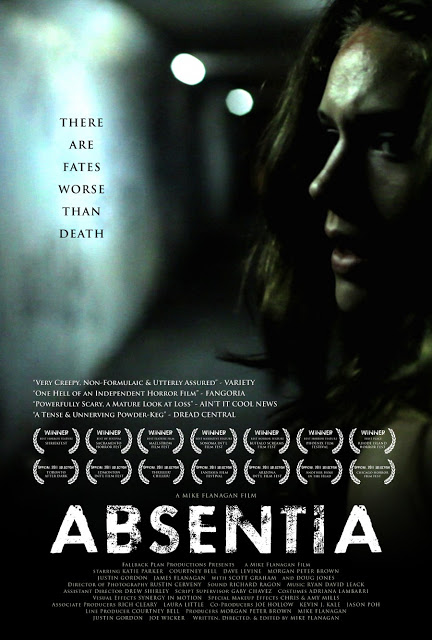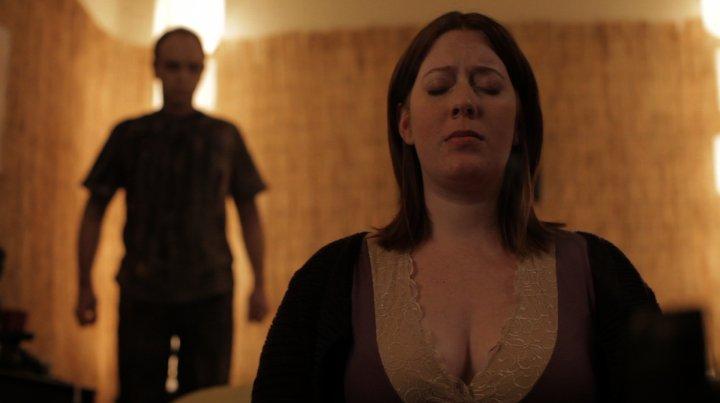Guest post written by Deirdre Crimmins.
Though I like explosions and interesting methods of execution as much as any other horror fan, it is always great characterization and relationships that make a horror film great. Actually, great characters and their relationships are what help make any film great, but often they are an afterthought in horror films. Too often we see a group of teenagers getting hunted by a maniac, and we never know any of their names or why they were poking around that abandoned cabin in the first place. And while I do like those sorts of films — I would even argue that torture porn films should have a place in horror’s canon — it is the films that have characters I care for that haunt me for years. And should that not be the goal for any horror film?
Last year’s Absentia is just such a film. I first saw it when it was making its lauded tour of the film festival circuit, and to this day certain scenes and concepts in it still disturb me. These images grab me in the middle of my day-to-day life and make me uneasy to continue on. Absentia terrified me, which is not an easy thing to do.
In addition to actually being scary (something that an unfortunate number of current horror films avoid) Absentia also features two lead female characters, and the bedrock of the film’s plot is their relationship. These two characters, sisters Callie (Katie Parker) and Tricia (Courney Bell) are not there simply to be eye candy, or to function as the lustful objects of affection for a killer, but rather they are there because they are both strong, flawed, and painfully relatable. It does not necessarily matter that they are women, but it matters more that they are family and that writer/director Mike Flanagan has created two fully formed characters, rather than all too common caricatures.
 |
| L-R: Callie (Katie Parker) and Tricia (Courtney Bell) in Absentia |
The film starts with the reunion of Callie and Tricia. Callie is the younger, free-spirited and troubled sister, who has wandered in and out of her sister’s life since they were young. She has come to be with Tricia at a time when Tricia needs her most. Seven years ago Tricia’s husband, Daniel (Morgan Peter Brown) disappeared without a trace. No note, no body — just gone. Tricia needs Callie there for strength as she mourns. She is no longer mourning the loss of Daniel, but now is struggling with the loss of hope. Tricia has decided to finally declare Daniel as dead in absentia. Callie is eager to be at Tricia’s side as she too is trying desperately to get her life back on track.
Tricia’s decision to legally acknowledge Daniel’s death has reignited a host of emotions that she has little to no control over. She has clearly moved on in some ways, as she is nearly 8 months pregnant with the lead detective’s child, but that does not stop her from the dread and guilt of finally letting go. Tricia has taken up Buddhist meditation as a way to calm and center herself, which is a mystery to the Catholic Callie.
Though the initial circumstances of the sister’s reunion seem more like a melodrama than a horror film, the film’s plot quickly twists and turns from there with each sister confronting their own demons (possibly literally) and negotiating their levels of trust in one another.
For Tricia, her biggest battle initially is that she keeps seeing Daniel. His image jumps out at her in the middle of the street, or at the back of her closet. And the Daniel she keeps seeing is not the Daniel she lost. He is gaunt, and in pain, and seems to be stalking her so that she cannot move on with her life. Each time Daniel pops up on screen, it makes you jump in fear. It is both startling, and the image itself of this disheveled, whimper of a man is disturbing. However these instances are not just the cheap jumps that would scare you in a haunted house. When Daniel is there, the camera does not flinch. Rather you get to see how painful it is for Tricia to be living in fear of these moments. She cannot escape the horror of her husband’s mysterious disappearance, and the prospect of never being able to live without him terrifies her. By watching her fright and seeing this woman who has been through so much continue to get emotionally berated that the real horror of her situation becomes clear. The horror is in Daniel’s lingering, and not in his sudden appearance.
Callie is having her own issues with the curious neighborhood she has moved to. It seems that people, and small animals, often go missing on Tricia’s street. There is a long dark tunnel just at their cul-de-sac that seems to keep calling Callie, though her instincts tell her to stay away. It is the lure of that tunnel, and what might be lurking beneath it, which is the true terror of the film.
I cannot emphasize enough how astoundingly convincing the two lead characters are. Both actresses deliver nuanced and genuine performances as believable sisters. These two have a long and complicated history together, and their relationship cannot be summed up with a single line of dialogue. However they do communicate their relationship by how they act around one another, how they fight, and how they forgive. You feel deeply for each of them, and understand the longing they each feel to be forgiven by one another for all of the issues in their past.
While I could continue on about the remarkable characterization of Callie and Tricia, it saddens me a little bit that strong non-sexualized female characters in horror films are such a unique phenomenon. While there are plenty of ass-kicking final women in slasher films, and many smart lady doctors who help stop the spread of a zombie outbreak, it is rare to feature a realistic female friendship, or a complicated sibling rivalry, in a horror film. Both Callie and Tricia are attractive, but that is not why they are there. The purpose that they are serving goes so far beyond their gender and their bodies that the contrast to other horror vixens seems like night and day. And neither of them plays the victim, or the unnaturally stoic heroine. They are both complex, and with long histories that they carry with themselves, and impact their judgments.
Had Absentia featured the relationship between two brothers, rather than the sisters, it would still be an artfully crafted, ambitious, successful, and utterly terrifying horror film. The fact that is does feature two multi-dimensional female leads makes it that much more satisfying and original. It is one of the few recent horror films that I recommend to every horror fan, without a single reservation.
———-
Deirdre Crimmins lives in Boston with her husband and two black cats. She wrote her Master’s thesis on George Romero and works too much.



